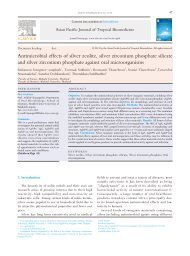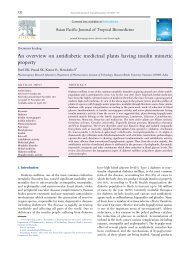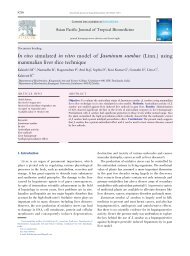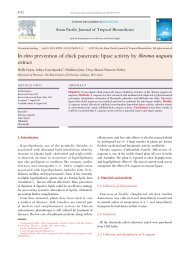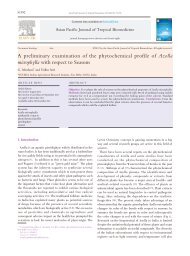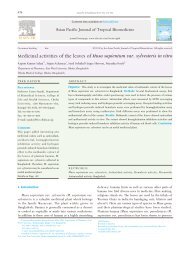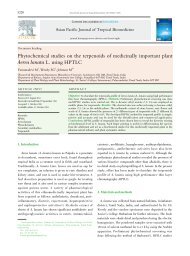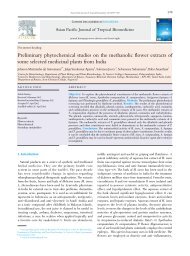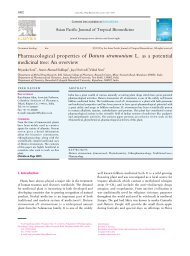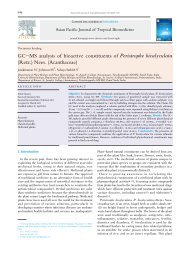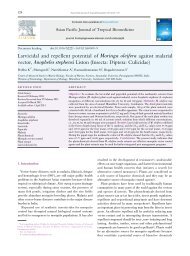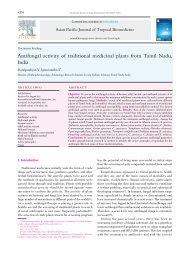Therapeutic potential of Terminalia chebula Retz ... - Apjtb.com
Therapeutic potential of Terminalia chebula Retz ... - Apjtb.com
Therapeutic potential of Terminalia chebula Retz ... - Apjtb.com
Create successful ePaper yourself
Turn your PDF publications into a flip-book with our unique Google optimized e-Paper software.
Table 2<br />
Structure and activities <strong>of</strong> some active <strong>com</strong>pounds and their derivatives from T. <strong>chebula</strong> <strong>Retz</strong>.<br />
induced strand breaks formation in plasmid PBR322 DNA<br />
was inhibited by aquesous extract <strong>of</strong> T. <strong>chebula</strong>[25]. The<br />
administration <strong>of</strong> aqueous extract <strong>of</strong> T. <strong>chebula</strong> prior to<br />
whole body irradiation <strong>of</strong> mice resulted in a reduction<br />
<strong>of</strong> peroxidation <strong>of</strong> membrane lipids in the mice liver as<br />
well as a decrease in radiation induced damage to DNA.<br />
It also protected the human lymphocytes from undergoing<br />
the gamma radiation-induced damage to DNA exposed<br />
in vitro[34]. T. <strong>chebula</strong> showed chemopreventive effect on<br />
nickel chloride -induced renal oxidative stress, toxicity<br />
and cell proliferation response in male Wistar rats[35].<br />
6.4. Hepatoprotective activity<br />
A mixture <strong>of</strong> chebulic acid (CA) and its minor isomer,<br />
neochebulic acid with a ratio <strong>of</strong> 2:1 isolated from<br />
ethanolic extract <strong>of</strong> T. <strong>chebula</strong> fruits showed strong<br />
hepatoprotective activity[36]. Ethanol extract T. <strong>chebula</strong><br />
was found to prevent the hepatotoxiocity caused by the<br />
adminstration <strong>of</strong> rifampicin, isoniazid and pyrazinamide<br />
(<strong>com</strong>bination) in sub-chronic model (12 weeks)[37].<br />
Protective effects <strong>of</strong> an aqueous extract <strong>of</strong> T. <strong>chebula</strong><br />
fruit on the tert-butyl hydroperoxide-induced oxidative<br />
injury was observed in cultured rat primary hepatocytes<br />
and rat liver have also been documented[28,29]. T. <strong>chebula</strong><br />
in a herbal formulation (HP-1) showed hepatoprotective<br />
activity against carbon tetrachloride induced toxicity in<br />
rat hepatocytes[38].<br />
6.5. Cardioprotective activity<br />
T. <strong>chebula</strong> extract pretreatment was found to ameliorate<br />
the effect <strong>of</strong> isoproterenol on lipid peroxide formation and<br />
retained the activities <strong>of</strong> the diagnostic marker enzymes<br />
in isoproterenol induced myocardial damage in rats[39]. Its<br />
pericap has also been reported to have cardioprotective<br />
activity in isolated frog heart model[40].<br />
Anwesa Bag et al./Asian Pac J Trop Biomed 2013; 3(3): 244-252 247<br />
Class <strong>of</strong> <strong>com</strong>pounds Compounds Plant parts Activities References<br />
Phenolic acid Ellagic acid Fruit Antibacterial activity against intestinal bacteria<br />
Clostridium perfringes, Escherichia coli;<br />
antiproliferative activity<br />
31,50<br />
Phenolic acid Chebulic acid Fruit Hepatoprotecttive, antioxidant and free radical<br />
scavenging activity, cytoprotective<br />
36,41<br />
Phenolic acid Neochebulic acid Fruit Hepatoprotecttive, antioxidant and free radical<br />
scavenging activity<br />
36<br />
Phenolic acid Gallic acid Fruit Antioxidant, antibacterial, antiviral, cytoprotective<br />
activity<br />
41,51,63<br />
Phenolics 2, 4-chebulyl-beta-D-glucopyranose Fruit Antiproliferative activity 31<br />
Phenolic acid Chebulinic acid Fruit Antiproliferative activity 31<br />
Benzoic acid Hydroxybenzoic acid derivatives Fruit Antioxidant activity 30<br />
Cinnamic acid Hydroxycinnamic acid derivatives Fruit Antioxidant activity 30<br />
Flavonoid Falvonol aglycones Fruit Antioxidant activity 30<br />
Glycosides Fruit Antioxidant, antibacterial activity 30,50<br />
Phenolic acid Chebulagic acid Fruit, Seed Cytoprotective, anti-arthritic activity 41,75<br />
6.6. Cytoprotective activity<br />
Gallic acid (GA) and CA were isolated from the extract<br />
<strong>of</strong> the herbal medicine Kashi (myrobalan, the fruit <strong>of</strong> T.<br />
<strong>chebula</strong>) as active principal that blocked the cytotoxic T-<br />
lyphocyte-mediated cytotoxicity. Granule exocytosis in<br />
response to anti-CD3 stimulation was also blocked by GA<br />
and CA at the equivalent concentrations[41]. The ethanolic<br />
extract <strong>of</strong> T. <strong>chebula</strong> fruit exhibited a notable cytoprotective<br />
effect on the HEK-N/F cells. In addition its extract exhibited<br />
significant cytoprotective effect against UV-induced<br />
oxidative damage. These observations were attributed to<br />
the inhibitory effect <strong>of</strong> the T. <strong>chebula</strong> extract on the age<br />
dependent shortening <strong>of</strong> the telomere length as shown by<br />
the Southern Blots <strong>of</strong> the terminal restriction fragments <strong>of</strong><br />
DNA extracted from sub-culture passages[42]. It exhibited<br />
the development <strong>of</strong> duodenal ulcers and appeared to exert<br />
a cytoprotective effect on the gastric mucosa in vitvo[43].<br />
Cytoprotective effect on oxidative stress and inhibitory effect<br />
on cellular aging <strong>of</strong> its fruits have also been documented[44].<br />
6.7. Antidiabetic and renoprotective activity<br />
T. <strong>chebula</strong> fruit and seeds exhibited dose dependent<br />
reduction in blood glucose <strong>of</strong> streptozotocin induced<br />
diabetic rats both in short term and long term study and also<br />
had renoprotective activity[45,46].<br />
6.8. Antibacterial activity<br />
T. <strong>chebula</strong> exhibited antibacterial activity against a<br />
number <strong>of</strong> both Gram-positive and Gram-negative human<br />
pathogenic bacteria[47-49]. Ethanedioic acid and ellagic acid<br />
isolated from butanol fraction <strong>of</strong> T. <strong>chebula</strong> fruit extract<br />
had strong antibacterial activity against intestinal bacteria,<br />
Clostridium perfingens and Escherichia coli[50]. It is effective<br />
in inhibiting the urease activity <strong>of</strong> Helicobactor pyroli,



